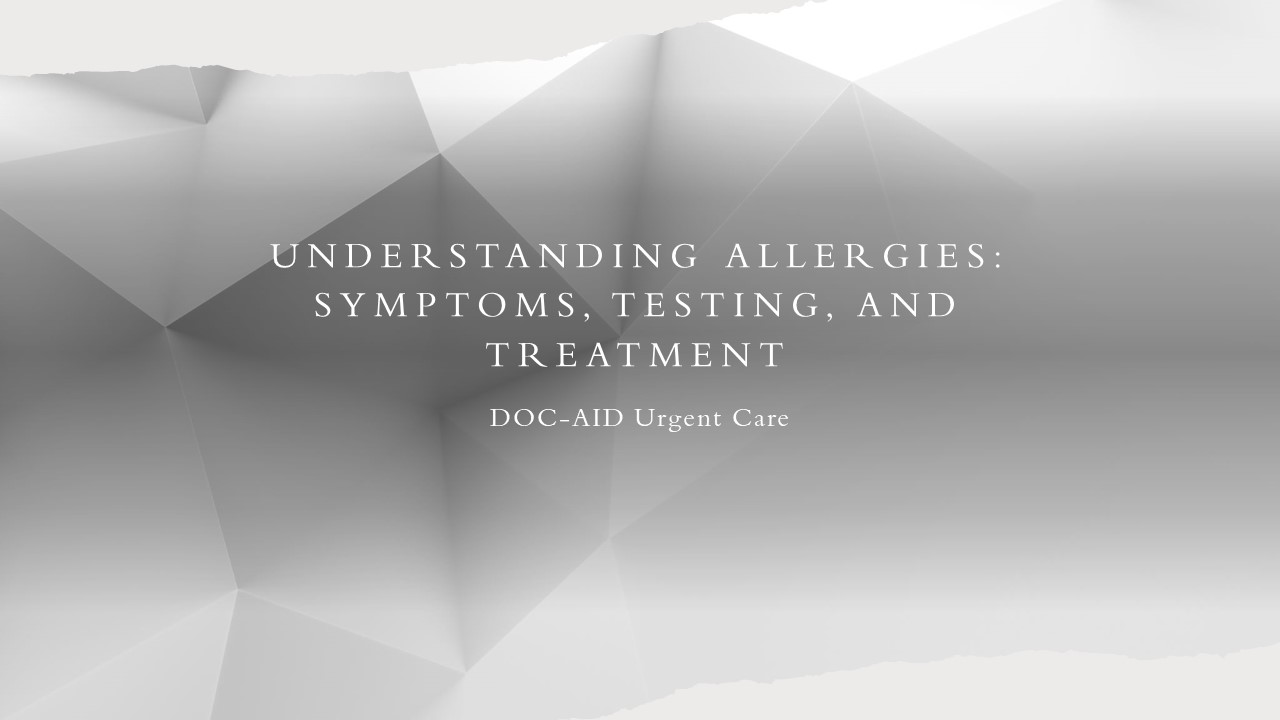Understanding Allergies: Symptoms, Testing, and Treatment - PowerPoint PPT Presentation
Title:
Understanding Allergies: Symptoms, Testing, and Treatment
Description:
Allergies occur when our immune system mistakenly reacts to a harmless substance. Different allergens, including food, insects, medication, dust, smoke, and animal dander, can cause these reactions. Knowing the various types of allergies is crucial to ensure that we prevent and treat them correctly. – PowerPoint PPT presentation
Number of Views:1
Title: Understanding Allergies: Symptoms, Testing, and Treatment
1
Understanding Allergies Symptoms, Testing, and
Treatment
- DOC-AID Urgent Care
2
What are common allergies?
- Allergies occur when our immune system mistakenly
reacts to a harmless substance. Different
allergens, including food, insects, medication,
dust, smoke, and animal dander, can cause these
reactions. Knowing the various types of allergies
is crucial to ensure that we prevent and treat
them correctly. - Allergens are substances that cause allergies,
including pollen, dust mites, animal dander,
certain foods, insect bites, medicines, latex,
mold, and household chemicals. usually do not
cause any reaction or symptoms in people who are
not allergic to them.
3
What are the symptoms of allergies?
- Allergies can affect various body parts,
including the airways, sinuses, lungs, skin, and
digestive system. The specific symptoms are
determined by the type of allergen involved. - To help you identify your allergy, weve listed
the symptoms associated with each type below - Hay fever or allergic rhinitis can lead
following - Sneezing
- Itching of the nose, eyes, or mouth
- Runny, stuffy nose
- Watery, red or swollen eyes (conjunctivitis).
4
- A food allergy can cause
- Tingling in the mouth
- Swelling of the lips, tongue, face, or throat
- Hives
- Anaphylaxis An insect sting allergy can cause
- A large area of swelling at the sting site
- Itching or hives all over the body
- Cough, chest tightness, wheezing, or shortness of
breath - Anaphylaxis
5
- A drug allergy can cause
- Hives
- Itchy skin
- Rash
- Facial swelling
- Wheezing
- Anaphylaxis
6
- Atopic dermatitis, an allergic skin condition,
can cause - Itchy skin
- Red, swollen skin
- Flakey or peeling skin
- Hives on the skin
- Anaphylaxis
- Anaphylaxis is a serious and potentially fatal
reaction triggered by certain allergies. It is
imperative to recognize the signs and symptoms of
anaphylaxis to seek immediate medical attention.
These may include - Loss of consciousness
- A drop in blood pressure
- Severe shortness of breath
- Skin rash
- Lightheadedness
- A rapid, weak pulse
- Nausea and vomiting
7
What is an allergy test?
- Allergy testing is a crucial diagnostic tool that
helps identify the specific allergens responsible
for triggering allergic reactions. By
administering small doses of allergens to
patients, allergists can accurately pinpoint the
culprits behind the reactions. This information
is invaluable in developing an effective allergy
treatment plan.
8
What types of allergy tests are there?
- There are two main types of allergy tests
- Skin Tests -There are multiple types of skin
tests available to determine allergies. During
the first type of skin test, known as a skin
prick test, a drop of a suspected allergen is
pricked on the surface of the skin. The test is
performed on the back of the arm, most commonly
the forearm. Many suspected allergens are tested
simultaneously. Redness and swelling occur at the
test spot if an allergic reaction occurs.If the
results from a skin prick test are unclear, a
second type of test may be recommended to rule
out false positives. In this type, known as a
skin injection test, a small amount of the
suspected allergen is injected into the skin of
the arm or forearm. Several suspected allergens
are tested simultaneously. - Blood Tests Blood tests can be used to
determine allergies, although they can produce
false positives and are not considered as
accurate as skin tests.
9
Where can I be treated for allergies?
- If you need allergy testing and diagnosis, visit
DOC-AID Urgent Care. Schedule an appointment or
use our Telehealth service from anywhere in
Texas. Our company strives to provide friendly
and compassionate help.































